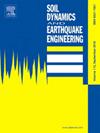Subgrade cumulative deformation probabilistic prediction method based on machine learning
IF 4.2
2区 工程技术
Q1 ENGINEERING, GEOLOGICAL
引用次数: 0
Abstract
To overcome the issues of limited generalization ability and unreliable prediction outcomes in subgrade cumulative deformation (SCD) models, a probabilistic prediction approach combining a data-driven neural network (DEDNN) and the Bootstrap method is introduced. Firstly, three DEDNN models are developed based on ANNs and empirical information, and the optimal DEDNN model is determined through a multi-level comprehensive assessment system. Secondly, four Bootstrap algorithms are used to modify the uncertainty in the optimal DEDNN model, namely Pairs, Residuals, Wild, and Moving Block Bootstrap, to develop and prefer the probabilistic prediction model for SCD.
Ultimately, the optimal probabilistic prediction model is employed to perform advanced prediction analysis, assessing the long-term deformation stability of the subgrade. With the help of a subgrade test section and the excitation test, a case study is carried out. The findings indicate that integrating empirical information with neural networks significantly improves the overall performance of SCD prediction models, identifying the empiricism-constrained neural network (ECNN) as the optimal DEDNN model. The prediction intervals obtained by the four Bootstrap algorithms cover the measured SCD values, and the Wild Bootstrap algorithm is determined to be the optimal Bootstrap algorithm because it has the smallest CWC value (0.5170 mm). The SCD is controlled within 4 mm at the end of the excitation test, and the prediction upper limit from the advanced probabilistic prediction is stabilized at 4.62183 mm, indicating that the long-term SCD value meets the requirements.
求助全文
约1分钟内获得全文
求助全文
来源期刊

Soil Dynamics and Earthquake Engineering
工程技术-地球科学综合
CiteScore
7.50
自引率
15.00%
发文量
446
审稿时长
8 months
期刊介绍:
The journal aims to encourage and enhance the role of mechanics and other disciplines as they relate to earthquake engineering by providing opportunities for the publication of the work of applied mathematicians, engineers and other applied scientists involved in solving problems closely related to the field of earthquake engineering and geotechnical earthquake engineering.
Emphasis is placed on new concepts and techniques, but case histories will also be published if they enhance the presentation and understanding of new technical concepts.
 求助内容:
求助内容: 应助结果提醒方式:
应助结果提醒方式:


